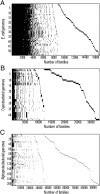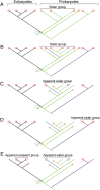Endosymbiotic gene transfer from prokaryotic pangenomes: Inherited chimerism in eukaryotes
- PMID: 25733873
- PMCID: PMC4547308
- DOI: 10.1073/pnas.1421385112
Endosymbiotic gene transfer from prokaryotic pangenomes: Inherited chimerism in eukaryotes
Abstract
Endosymbiotic theory in eukaryotic-cell evolution rests upon a foundation of three cornerstone partners--the plastid (a cyanobacterium), the mitochondrion (a proteobacterium), and its host (an archaeon)--and carries a corollary that, over time, the majority of genes once present in the organelle genomes were relinquished to the chromosomes of the host (endosymbiotic gene transfer). However, notwithstanding eukaryote-specific gene inventions, single-gene phylogenies have never traced eukaryotic genes to three single prokaryotic sources, an issue that hinges crucially upon factors influencing phylogenetic inference. In the age of genomes, single-gene trees, once used to test the predictions of endosymbiotic theory, now spawn new theories that stand to eventually replace endosymbiotic theory with descriptive, gene tree-based variants featuring supernumerary symbionts: prokaryotic partners distinct from the cornerstone trio and whose existence is inferred solely from single-gene trees. We reason that the endosymbiotic ancestors of mitochondria and chloroplasts brought into the eukaryotic--and plant and algal--lineage a genome-sized sample of genes from the proteobacterial and cyanobacterial pangenomes of their respective day and that, even if molecular phylogeny were artifact-free, sampling prokaryotic pangenomes through endosymbiotic gene transfer would lead to inherited chimerism. Recombination in prokaryotes (transduction, conjugation, transformation) differs from recombination in eukaryotes (sex). Prokaryotic recombination leads to pangenomes, and eukaryotic recombination leads to vertical inheritance. Viewed from the perspective of endosymbiotic theory, the critical transition at the eukaryote origin that allowed escape from Muller's ratchet--the origin of eukaryotic recombination, or sex--might have required surprisingly little evolutionary innovation.
Keywords: endosymbiosis; evolution; lateral gene transfer; mitochondria; plastids.
Conflict of interest statement
The authors declare no conflict of interest.
Figures




References
-
- Szathmáry E, Smith JM. The major evolutionary transitions. Nature. 1995;374(6519):227–232. - PubMed
-
- Lane N. Life Ascending: The Ten Great Inventions of Evolution. Norton; New York: 2009.
-
- Lane N, Martin W. The energetics of genome complexity. Nature. 2010;467(7318):929–934. - PubMed
-
- Williams TA, Foster PG, Cox CJ, Embley TM. An archaeal origin of eukaryotes supports only two primary domains of life. Nature. 2013;504(7479):231–236. - PubMed
Publication types
MeSH terms
Substances
Grants and funding
LinkOut - more resources
Full Text Sources
Other Literature Sources

